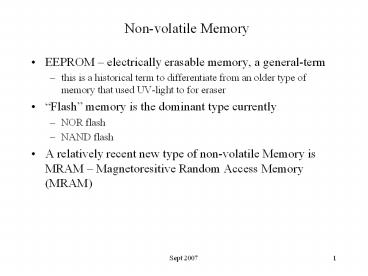Non-volatile Memory - PowerPoint PPT Presentation
1 / 16
Title:
Non-volatile Memory
Description:
Non-volatile Memory EEPROM electrically erasable memory, a general-term this is a historical term to differentiate from an older type of memory that used UV-light ... – PowerPoint PPT presentation
Number of Views:257
Avg rating:3.0/5.0
Title: Non-volatile Memory
1
Non-volatile Memory
- EEPROM electrically erasable memory, a
general-term - this is a historical term to differentiate from
an older type of memory that used UV-light to for
eraser - Flash memory is the dominant type currently
- NOR flash
- NAND flash
- A relatively recent new type of non-volatile
Memory is MRAM Magnetoresitive Random Access
Memory (MRAM)
2
NOR Rom
Weste/Harris F11.35
3
NAND ROM
Weste/Harris F11.41
4
NOR Flash
Floating gate
Wikipedia image 2007
5
Floating Gate Operation
6
Floating Gate for NOR Flash Programming
Electrons flowing in channel from drain to source
attracted to 12v on the programming gate, become
trapped on floating gate, giving it a negative
charge.
Wikipedia image 2007
7
Floating Gate for NOR Flash Erase
12v on drain attracts trapped charge on floating
gate and removes the electrons.
Wikipedia image 2007
8
NAND Flash
Standard NAND flash has 8 transistors in parallel.
Wikipedia image 2007
9
NAND vs NOR Flash
Toshiba
10
NAND vs. NOR Flash
- NAND denser than NOR because of smaller cell size
- preferred for data memory storage (flash drives)
- NAND is about 2x denser than NOR because of
layout efficiencies due to series transistors
(less metal contacts) - NAND slower read time because of stacked cell
arrangement - NOR preferred as program memory storage for
microcontrollers because of faster access time - NAND is always block read/block write NOR allows
read of individual memory locations - NAND programming/erase is faster than NOR
programming/erase
11
NAND/NOR Flash Limitations
- Both NAND/NOR memory has limited number of
programming/erasure cycles - About 100,000 cycles is a typical number, even
though cells with higher cycle numbers can be
designed - The Data memory EEPROM cells (100K minimum
cycles, 1M max) in the PIC microprocessors are
designed to have about 10X the maximum number of
programming/erase cycles as the program memory
EEPROM cells (10K minimum cycles, 100K max)
12
MRAM Magnetoresitive Random Access Memory
- Semiconductor memory that uses magnetic storage
elements - Advantages
- Non-volatile
- Fast Read/Write (nanoseconds)
- Random access
- Unlimited read/write (does not degrade with usage
like Flash) - Radiation hard (military applications)
- Disadvantages
- Tough to scale down, IBM believes that scaling
past 65 nanometer is impractical - Stray magnetic fields can impact them, but
packaging by Vendors gives more than adequate
protection from typical stray encountered fields - Uses
- Proponents believe will replace flash memory on
microcontrollers since these are not usually
fabed with the most aggressive technologies, and
some applications can benefit from the fast write
times, and unlimited writes - Could also replace SRAM/DRAM use in embedded
systems.
13
MRAM Cell
Essentially a resistor with two different
resistances depending on if the magnetic fields
of the two plates are in the same direction or
opposite directions
Magnetic Tunnel Junctions (MJT)
Wikipedia image 2007
14
MRAM Cell (Freescale)
Pulses are applied to both write lines to
generate a mag. field that rotates the mag.
polarity of the top film (field-switching write)
Resistance of Magnetic Tunnel Junctions (MJT) is
high when oppositely aligned, low when aligned.
Freescale image 2007, app. note
15
MRAM Operation
- Two thin-film ferromagnetic films are used
- magnetic polarization of one film is fixed, the
other is free to be changed to aligned to be the
same or opposite of fixed field - Electrons have two spins, up and down, about
50 distributed and this changes as electrons
move - When electrons pass through ferromagnet, spins
become spin-polarized - parallel with magnetic field (up), majority
carrier - anti-parallel with magnetic field (down),
minority carrier - down spin electrons are scattered, up spin
electrons are not - Electrons passing through two thin plates with
same aligned fields means that only type of
electron spin is scattered (looks like like low
resistance, more electrons get through) - Electrons passing through two thin plates with
opposite-aligned fields means that both types of
spin is scattered (looks like high resistance,
less electrons get through).
16
MRAM Device (Freescale)
0.18u technology
Freescale datasheet

